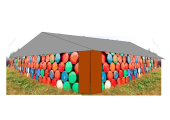Thank you for the good info!
I have considered something similar in regards to the Great Room span. I have a couple of huge oak trees (30"+) that have to come out and a 6"x18"x27' bridge beam. I see rustic oak post & beam or maybe the steel beam made rustic/rusty.
With rock, gravel and sand 3 miles away @ $7-$12 a ton, there will likely be a fair bit of masonry projects around here.
The fireplace is as much for ambiance as for heat & we want it far from my bedroom. There was method to my madness in picking that location

Yes, I am following that build. Very cool!!
Thanks for the replies.











